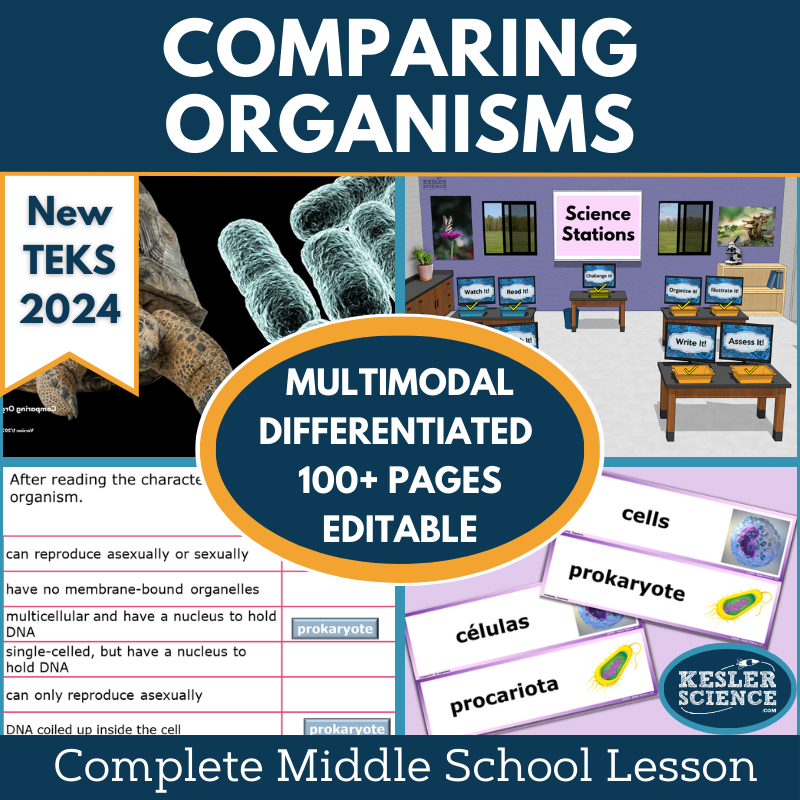
Comparing Organisms Complete Science Lesson - New TEKS 6.13B
This complete unit provides middle school teachers with everything needed to teach students how to identify and compare the basic characteristics of organisms. Students investigate and contrast prokaryotic and eukaryotic cells, unicellular and multicellular organisms, and autotrophic versus heterotrophic nutrition. The resource includes editable presentations, worksheets, student-choice projects, a differentiated station lab, and assessments. Built for multiday use with minimal prep, this lesson emphasizes student-led, differentiated learning so teachers can focus on facilitating deeper understanding.
Essential Question for Students
-
How do the terms in each pair of characteristics compare to one another: prokaryote and eukaryote, multicellular and unicellular, and autotroph and heterotroph?
Standards Alignment: Meets 2021 TEKS standard 6.13B.
Key Features
-
Differentiated materials for students who need extra support or enrichment
-
Multimodal learning activities to keep students engaged and accountable
-
Flexible delivery in both printable and digital formats
-
Editable PowerPoints for classroom customization
-
Spanish translations of vocabulary, a station lab passage, and interactive notebook pages
Instructional Framework: The 5E Model
This lesson is built on the 5E instructional model—Engage, Explore, Explain, Elaborate, Evaluate—providing a balance of inquiry, practice, and assessment.
Engage
-
Objectives and Word Wall Cards (English & Spanish)
-
Teacher file with class discussion prompts, activity suggestions, and notes on misconceptions
Explore
-
A nine-station, student-led lab guiding students to compare organisms by cell type, structure, and energy acquisition
Input Stations:
-
Explore It! – Hands-on demo or experiment
-
Read It! – Differentiated reading passages (English & Spanish) with comprehension questions
-
Research It! – Online activity with tasks and guided questions
-
Watch It! – Short video followed by discussion and reflection
Output Stations:
-
Organize It! – Printable/digital card sorts for classification and categorization
-
Write It! – Open-ended written responses in complete sentences
-
Illustrate It! – Sketching/drawing to reinforce concepts visually
-
Assess It! – Task cards and vocabulary-in-context questions
Bonus Station:
-
Challenge It! – Crosswords, puzzles, or mini-projects for enrichment and early finishers
Explain
-
Editable PowerPoints in standard and interactive versions
-
Interactive Notebook templates (digital & print, English & Spanish)
-
Note-taking organizers to support guided instruction
Elaborate
-
Student-choice projects to extend learning by applying classification concepts
Evaluate
-
Assessments updated for STAAR 2.0, with standard and modified versions
-
Review questions and worksheets for practice, homework, or test prep
Flexible Learning Options
This lesson is designed for both in-class and virtual instruction. The digital station lab and interactive notebook activities are fully compatible with PowerPoint and Google Slides, making it simple to use in blended or online environments.
This is a finished product; it will be updated with corrections as needed. Future improvements and new features will be sold as a separate product.
Pickup currently not available
Terms of Use
Copyright © Kesler Science, LLC. All rights reserved by the author. This product is to be used by the original downloader only. Copying for more than one teacher, classroom, department, school, or school system is prohibited. Permission is never granted to enter Kesler Science materials into any form of AI for any purpose. This product may not be distributed or displayed digitally for public view. Failure to comply is
copyright infringement and a violation of the Digital Millennium Copyright Act (DMCA). Clipart and elements found in this PDF are
copyrighted and cannot be extracted and used outside of this file without permission or license. Intended for classroom and personal use ONLY. Multiple licenses are available for purchase by departments,
schools, or school districts. Contact support@keslerscience.com for more information.


















